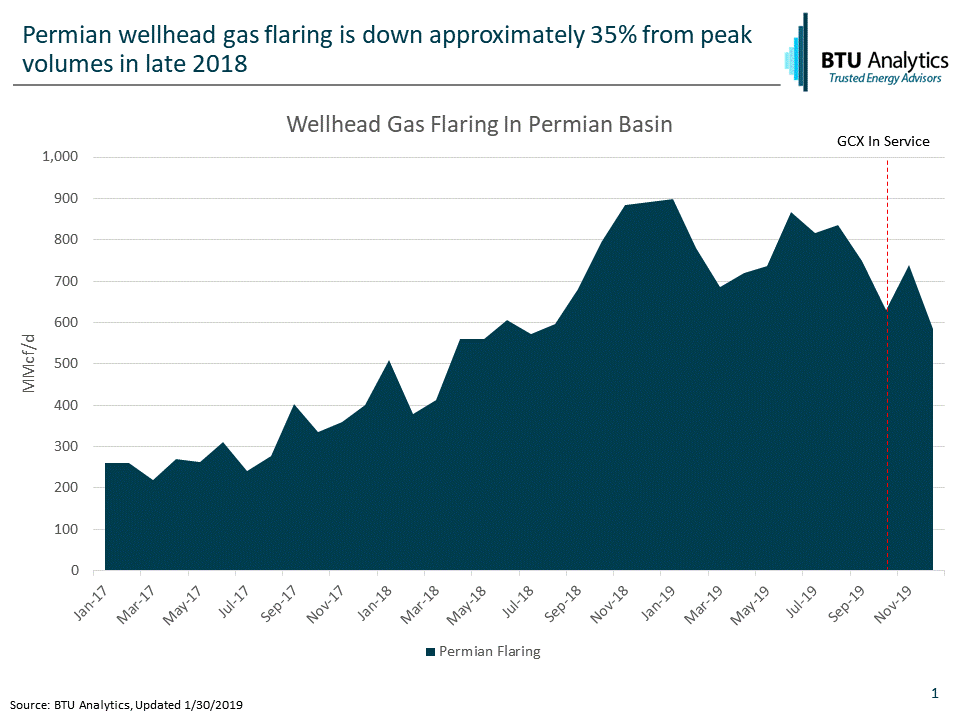Despite the start of Gulf Express Pipeline (GCX) in September 2019, Waha natural gas spot prices are trading at $0.43/MMBtu as of Feb. 4, 2020. BTU Analytics’ most recent data indicates flaring volumes in the Permian were around 580 MMcf/d through the end of December 2019, down from peak volumes in late 2018 of just under 900 MMcf/d. However, Permian gas pipelines are once again full and oil production remains on the uptick, and with it, associated natural gas volumes. Looking into 2020, will operators be able to continue to advance corporate environmental, social, and governance (ESG) goals and maintain production targets at the same time? Today’s energy market commentary will focus on Permian producer ESG goals and the potential impacts to volumes should flaring curtail production.

Environmental, Social, and Governance (ESG) funds are becoming ever more popular among investors. According to Morningstar, as of 3Q19, flows into open-ended and exchange-traded ESG funds for the first three quarters of 2019 were approximately $13.5 billion dollars, which is on pace to triple the flows into these same funds in 2018 of just $5.5 billion. As interest in investing more into ESG type funds and companies increases (and the present potential for divestment from companies not seen as ESG friendly), some operators are facing investor pressure to address how they plan to make moves towards being more ESG friendly.
In recent years, many operators have started releasing climate impact reports, which address some of these investor questions. For example, in a recent climate report, Occidental (NYSE: OXY) has pledged to eliminate routine flaring of natural gas by 2030. EOG Resources (NYSE: EOG) put out in their 2018 climate report that they will be reducing flaring due to the installation of more gathering infrastructure and procuring firm transport for their natural gas. Apache (NYSE: APA) put out in their 2019 climate report that they have since begun implementing automated choke systems to decrease production or shut in wells to reduce flaring, in the Permian specifically. Below is a chart showing the changes in flaring that are attributed to some of the top Permian producers by flaring volumes.

Looking at historical flared volumes for a subset of Permian operators highlights some challenges producers might face as they try to balance production targets with ESG goals. Several of these operators, such as OXY, EOG, and XEC have flaring volumes down to under 5% of their gross gas production. EOG 2018 compared to 2019 specifically highlights moving in the direction indicated in their climate report, with flaring volumes in 2019 down from 2018, and the percentage of gas production that is flared is down by half, indicating they are producing more and flaring relatively less. However, some operators increased flaring in 2019 due to growing pipeline constraints, and as gas takeaway capacity remains scarce in 2020 and production continues to grow, operators will be faced with the difficult decision on how to manage production, flaring, and ESG goals.
If operator ESG goals or stricter flaring regulations are implemented and lead producers to eliminate flaring all together, just between these 10 operators, that adds around 300 MMcf/d of gross gas to a system today. Additionally, if these 10 operators were forced to stop flaring gas altogether and shut in the oil production associated with these wells, the below chart shows an upper bound of 1.2 MMb/d of oil at risk. Note, this example assumes that operators choose to shut in oil production on flared wells and are not able to find another solution to manage gas production.

However, operators would likely choose between a combination of options if they were forced to eliminate flaring. This includes strategies like choking wells to reduce overall volumes or shutting in their highest Gas-to-Oil-Ratio (GOR) wells. High GOR wells represent wells with relatively larger gas volumes than oil volumes and whose economics will be weighted to gas prices rather than oil. There are approximately 800 MMcf/d of high GOR wells with GPMs<1.5 in the Permian and the associated oil production to these wells is roughly 30 Mb/d. Shutting in these wells is an example of a lever operator could pull to help reduce the need to flare gas in the Permian while leaving oil production largely unchanged. However, infrastructure and producer production mixes suggest that the operators with the largest need to flare or shut-in production may not be the same operators with large volumes of high GOR wells.
Therefore, as investors continue looking to put money towards more ESG related options, operators may face difficult decisions to balance oil production and flaring until new pipelines arrive. For more information on how BTU Analytics’ flaring and shut-in estimates affect production outlooks, as well as when Permian gas takeaway constraints could end, request a sample of our Upstream Outlook Report.









